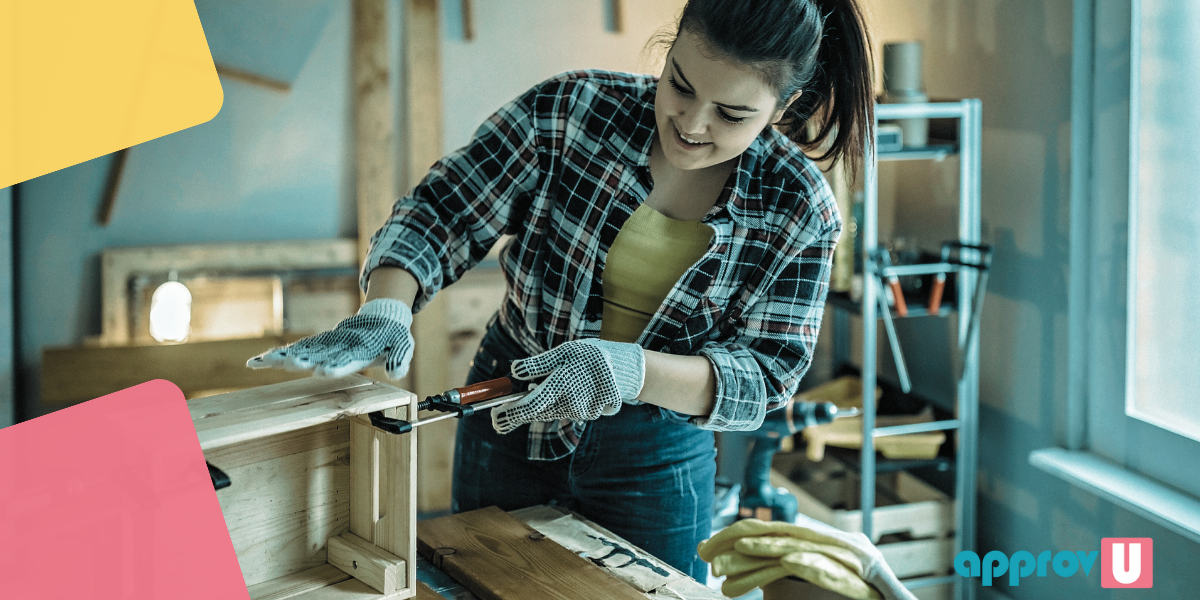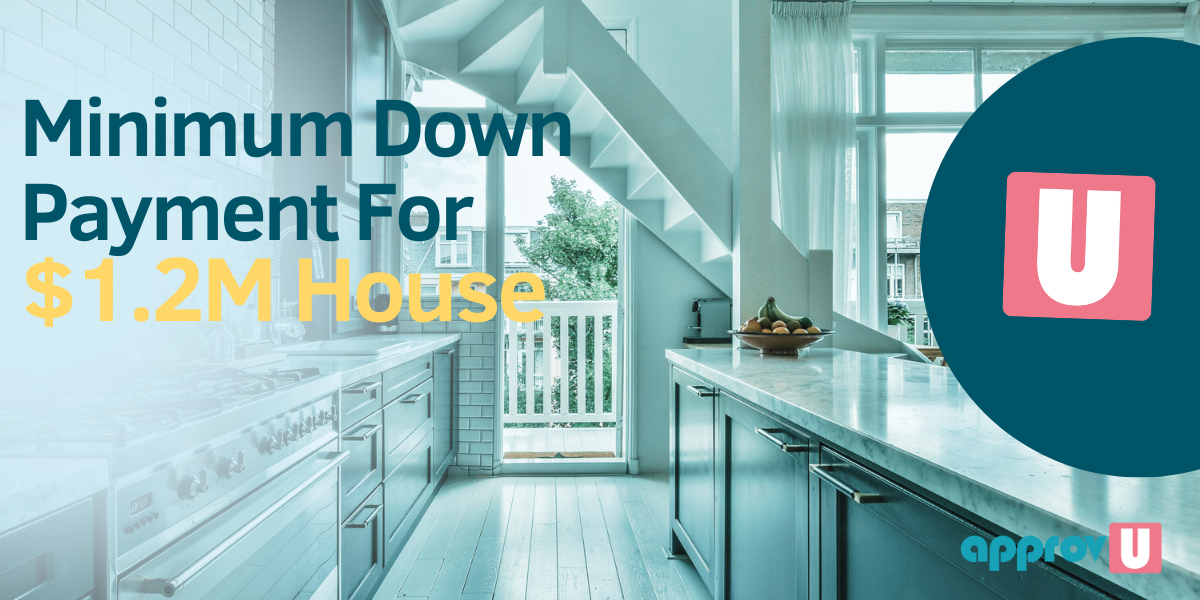You’ve been staring at those same walls, walking on that familiar floor, and lounging in that age-old living room for ages.
While the comfort of familiarity is undeniable, there’s also something invigorating about giving your space a fresh, new look.
The good news?
You don’t need to hire a professional team or spend a small fortune to bring a touch of novelty to your home.
DIY home improvement projects allow you to infuse a personal touch into your living space and offer a sense of accomplishment that’s uniquely satisfying.
Whether you’re a seasoned DIY enthusiast or just starting, this list will guide you through ten transformative projects that promise to enhance the appeal and comfort of your abode.
Dive in, get your hands dirty, and watch your living space evolve into a more beautiful version.
Repainting Walls
Imagine the transformation a new shade of paint can bring to your living space.
Just like putting on a new outfit, giving your walls a fresh coat of paint can dramatically change the mood and atmosphere of a room.
If you’ve been yearning for a refresh, here’s your chance.
Choosing the Right Colour Palette
Before you start, deciding on a colour scheme that reflects your personality and complements your furniture and décor is essential.
Warm colours like reds and oranges can make a room feel cozy and intimate, while cool shades like blues and greens offer a calm, serene vibe.
If uncertain, consider neutral tones like beige, gray, or white, which provide a versatile canvas for any style.
Tips for a Professional-looking Paint Job
- Preparation is key: Ensure your walls are clean, and patch any holes or imperfections with filler. A smooth surface ensures a flawless finish.
- Invest in quality tools: Good-quality brushes and rollers can significantly improve the result. Remember, a brush for edges and a roller for larger surfaces.
- Primer: If you’re going for a lighter colour or need to cover a dark or bold shade, priming your walls can ensure better paint adherence and a more even result.
- Edge first: Always paint the edges and corners of a wall first (known as ‘cutting in’) before moving to the broader strokes to avoid visible brush lines.
- Multiple coats: Depending on the colour and quality of the paint, you might need two or even three coats to achieve a rich and even finish. Allow each layer to dry thoroughly before applying the next.
Remember, repainting is more than just aesthetic enhancement.
It’s an expression of your style and taste.
So, put on some music, roll up your sleeves, and watch as each brushstroke breathes new life into your home.
Installing Floating Shelves
Floating shelves have become an indispensable part of contemporary home décor.
They are stylish and optimize your wall space, allowing you to display cherished mementos, books, or plants.
If you want to add functional flair to your walls, here’s how to go about it.
Picking the Right Materials and Design
Your choice of material can profoundly influence the aesthetics and durability of your shelves.
Popular options include solid wood for a rustic or traditional look, laminated MDF for a sleek modern vibe, and glass or acrylic for a minimalist touch.
Take a moment to assess the décor of your room and select a material and design that harmonizes with it.
Step-by-Step Guide for Installation
- Plan Your Layout: Decide where you want the shelves to be. Consider using painter’s tape to mark the prospective positions, ensuring they’re level.
- Gather Your Tools: Typically, you’ll need a drill, screws, wall anchors (especially if you’re not drilling into studs), a level, and a pencil.
- Mark and Drill: Once you know the position, mark the drilling spots. If you’re not drilling into studs, you’ll need to use wall anchors to ensure the shelves have a sturdy hold.
- Fix the Brackets: Most floating shelves have hidden brackets or mounting hardware. Secure these to the wall first.
- Attach the Shelf: Once your brackets are in place, slide or fix your shelf onto them. Make sure it sits securely.
- Check the Level: Use a level to ensure the shelf is straight. The last thing you want is a slanted shelf!
With your new floating shelves in place, you’ve added extra storage and an element of design that’s uniquely you.
Whether you’re showcasing a collection of vintage novels, family photos, or succulent plants, your walls now have a story to tell, and it’s all thanks to your DIY prowess.
Upcycling Old Furniture
There’s a certain charm in breathing new life into old furniture.
While tossing outdated or worn pieces is tempting, upcycling melds the past with the present, creating items that carry memories and modern flair.
And who better to transform these treasures than you?
Ideas for Repurposing Chairs, Tables, and Dressers
- Chairs: An old chair can be transformed with new upholstery or by painting it a bold colour. Consider turning it into a unique plant stand or a bedside table.
- Tables: Refinish that worn-out coffee table with varnish or give it a distressed look. If you have an old wooden ladder, think about horizontally suspending it between two chains for an inventive and rustic hanging shelf.
- Dressers: Swap outdated knobs or handles for modern ones. Consider removing drawers and adding shelves, turning your dresser into a chic open storage unit.
Techniques for Refinishing and Painting
- Cleaning: Clean the furniture thoroughly, removing any dust or old polish.
- Sanding: For wooden furniture, sanding is essential to achieve a smooth surface. It also helps the paint or stain adhere better. Use finer grit sandpaper for a polished finish.
- Priming: Apply a suitable primer, especially if switching from a dark to a light shade.
- Painting: Choose a paint suitable for furniture. Whether matte, satin, or glossy, pick a finish that resonates with your style.
- Protecting: Seal your hard work with a clear protective finish like varnish or wax to ensure durability.
Remember, upcycling isn’t just about beautifying old items.
It’s a journey of seeing potential where others might see waste.
As you delve into these projects, you’re not just crafting pieces of furniture; you’re weaving stories, memories, and a touch of your essence into every nook and cranny of your home.
Creating a Home Garden
A touch of green can act as a refreshing oasis in urban sprawl and concrete jungles.
Cultivating a garden, indoors or outdoors, offers more than just visual appeal;
it provides an intimate connection with nature, a meditative escape, and even the joy of harvesting your produce.
If the idea of being surrounded by nature’s beauty appeals to you, it’s time to roll up your sleeves and bring that vision to life.
Options for Indoor and Outdoor Gardens
- Indoor Gardens: If you’re limited by space or weather conditions, indoor gardens can be a game-changer. Think of potted plants, hanging terrariums, or hydroponics. Plants like snake plants, pothos, and succulents are aesthetically pleasing and relatively low maintenance.
- Outdoor Gardens: If you have a backyard or even a small balcony, the sky’s the limit. There’s a world of options, from vibrant flower beds to functional vegetable patches. Consider raised beds, vertical gardens, or container gardening if space is a constraint.
Benefits of Having a Green Space in Your Home
- Air Quality: Plants act as natural air purifiers, removing toxins and releasing oxygen, giving you fresher air to breathe.
- Mental Well-being: Engaging with plants, nurturing them, and watching them grow can be therapeutic. It’s a momentary escape from digital screens and urban chaos.
- Aesthetic Appeal: A well-maintained garden is visually soothing and can be an instant mood lifter. Plus, it’s a great conversation starter!
Embarking on your gardening journey can be as simple as planting a single seed or as elaborate as designing a landscape.
Remember, it’s not just about the plants; it’s about the joy of nurturing, the thrill of growth, and the peace that greenery brings.
So, whether you have a green thumb or not, dive into this venture. Your home and soul will thank you for it.
Revamping Your Lighting
Lighting, often underestimated, is a transformative element in any living space.
Just like how a sprinkle of seasoning can change the flavour of a dish, the right lighting can elevate the ambiance of your room, highlighting its best features and setting the desired mood.
If you’ve felt that certain parts of your home lack lustre or warmth, it’s time to reconsider your lighting choices.
Introduction to Popular Lighting Options
- Pendant Lights: These hang down from the ceiling, offering both general illumination and a decorative touch. They’re perfect over kitchen islands, dining tables, or reading nooks.
- LED Strips: Versatile and energy-efficient, LED strips can be adhered behind TVs, under cabinets, or even along baseboards, providing a modern and atmospheric glow.
- Table and Floor Lamps: These portable fixtures are excellent for creating focused light in specific areas, be it for reading, crafting, or just cozying up in a corner.
How to Choose the Right Illumination for Different Spaces
- Purpose: Determine the primary purpose of the room. Do you need ambient lighting for a relaxing bedroom, task lighting for a home office, or accent lighting to highlight art pieces?
- Layering: A single light source rarely does justice to a space. Consider layering different types of lights. Combine ceiling lights with wall sconces or floor lamps to achieve a balanced look.
- Colour Temperature: Pay attention to the warmth or coolness of the light. Warmer hues (yellowish) are cozy and inviting, ideal for living rooms and bedrooms. Cooler lights (whitish or bluish) are better suited for bathrooms or workspaces.
- Dimmers: Installing dimmer switches gives you the flexibility to adjust the brightness as per the time of day or the activity, setting the perfect mood.
Rethinking your lighting isn’t merely about the fixtures or the bulbs.
It’s about envisioning how light plays within your space, casting shadows, revealing textures, and creating an atmosphere that mirrors your essence.
So, as you flip that switch, remember: you’re not just illuminating a room; you’re crafting an experience, one that beckons, soothes, and inspires.
Installing a Backsplash in the Kitchen
The kitchen, often dubbed the heart of the home, isn’t just a place for culinary adventures; it’s a canvas for your creativity.
While cabinets and countertops often get the limelight, the backsplash – that modest wall space between your countertop and upper cabinets – can make a world of difference in the aesthetics of your kitchen.
If you’re seeking a functional and fabulous makeover, a DIY backsplash is a project you’ll want to tackle.
Benefits of a Kitchen Backsplash
- Protection: Cooking can get messy. A backsplash guards your walls from spills, splashes, and stains, making cleanup a breeze.
- Aesthetics: From colourful tiles to intricate patterns, the design possibilities are endless, letting you infuse personality into your kitchen.
- Value: A well-done backsplash can elevate the overall look of your kitchen, potentially increasing the value of your home.
Tile Selection and Installation Guide
- Material Choices: Ceramic tiles are popular due to their durability and cost-effectiveness. However, if you wish to splurge, consider glass, stone, or even stainless steel options.
- Design and Pattern: Think about the look you want to achieve. Do you fancy a classic subway tile pattern, a herringbone design, or a mosaic? The tile’s shape, size, and colour will significantly affect the outcome.
- Preparation: Ensure the wall is clean, dry, and smooth. If there are imperfections, consider sanding or patching.
- Laying It Out: Before adhering, lay your tiles on the countertop in your desired pattern. This dry run will help you visualize the final look and make necessary adjustments.
- Adhesive: Use a tile adhesive or thin-set mortar to stick the tiles. Apply it with a notched trowel for even distribution.
- Cutting Tiles: You might need to cut tiles to fit the edges or around the outlets. A tile cutter or a wet saw will be handy for this.
- Grouting: Once the tiles are set and the adhesive has dried (usually 24 hours), apply grout between the tiles. Wipe away excess with a damp sponge.
- Sealing: To prevent moisture infiltration and staining, especially if you’ve used natural stone tiles, seal the backsplash with a suitable sealer.
By the end of this project, you’ll step back and marvel at the transformation.
Through your efforts, that once-overlooked wall space becomes a focal point, reflecting your style and making every culinary endeavour more delightful.
So, while you whip up your favourite dishes, let your backsplash be a testament to your taste and tenacity.
DIY Home Office Setup
In today’s digital age, the boundaries between home and work have become increasingly fluid.
Whether you’re a full-time remote worker, a part-time freelancer, or someone who occasionally brings work home, having a dedicated workspace is paramount.
Creating a functional and inspiring home office is not just about having a desk and a chair; it’s about crafting an environment where your productivity and creativity soar.
Ready to design that perfect workspace?
Here’s how.
Importance of a Dedicated Workspace
- Focus: Having a distinct area for work helps mentally separate professional tasks from domestic distractions, allowing you to dive deep into your assignments.
- Ergonomics: A proper setup, tailored to your comfort, can prevent physical strain, ensuring you work efficiently without compromising your health.
- Professionalism: If your job involves video calls or virtual meetings, a neat, organized backdrop conveys professionalism.
Ideas for Organization and Furniture Arrangements
- Selecting the Right Spot: Not everyone has the luxury of a separate room for an office. But even a quiet corner in your living room or bedroom can suffice. Look for areas with good natural light and minimal noise.
- Invest in Comfort: Choose an ergonomic chair that supports your posture. Your desk should have ample space for your computer, essential tools, and a little room for personal touches.
- Storage Solutions: Think vertically. Install shelves above your desk for books or essential files. Consider using drawer organizers or storage boxes to keep things tidy.
- Personalize: This is your space. Add personal touches like family photos, inspirational quotes, or artwork that motivates and calms you. Plants can also be a great addition, offering a touch of nature and improving air quality.
- Tech Setup: Organize your cables using clips or sleeves. Invest in good-quality headphones, especially if your home can be noisy. If video calls are a norm, ensure a neutral or professional backdrop and adequate lighting.
- Lighting: While natural light is ideal, ensure you also have task lighting for those late-night work sessions or cloudy days.
Embarking on your DIY home office setup is not just about functionality; it reflects who you are as a professional.
Each element, from the desk’s placement to the colour of the walls, should resonate with your work style and aspirations.
So, as you set up each component, remember you’re not just organizing furniture and tools; you’re paving the way for successes, breakthroughs, and many productive days ahead.
Updating Bathroom Fixtures
Though often overlooked, the bathroom plays a pivotal role in setting the tone for your day.
From those invigorating morning showers to the relaxing evening baths, it’s a sanctuary of rejuvenation.
Given its significance, doesn’t it deserve a touch-up? Refreshing its look can be as simple as updating its fixtures.
And the best part?
You can make these changes all by yourself.
Replacing Faucets, Showerheads, and Other Fixtures
- Faucets: If your sink faucet looks dated or has seen better days, consider upgrading to a modern design. Today’s faucets come in various finishes, from matte black to brushed gold, letting you match or contrast with your existing bathroom decor.
- Showerheads: Swap out that old showerhead for one with multiple spray settings or a luxurious rainfall design. Not only can this enhance your showering experience, but water-saving models can also reduce your utility bills.
- Other Fixtures: Consider updating towel racks, toilet paper holders, and cabinet handles. These small changes can make a substantial visual difference.
Benefits of Modern, Water-Saving Options
- Eco-friendly: Modern fixtures often have water-saving features that reduce water use without compromising performance.
- Cost-saving: While there’s an initial investment, these fixtures can lead to significant savings on your water bills over time.
- Enhanced Experience: Newer designs offer better functionality, aesthetics, and overall user experience, turning mundane routines into delightful moments.
Tips for a Smooth Replacement
- Compatibility: Before purchasing, ensure the new fixtures are compatible with your bathroom’s existing setup in size, fit, and plumbing requirements.
- Shut Off the Water: Before you begin any replacements, always turn off the water supply to avoid unexpected (and wet) surprises.
- Tools Ready: Adjustable wrenches, Teflon tape, and plumber’s putty are a few essentials you might need.
- Follow Instructions: While the excitement to see the new fixture in place is understandable, take a moment to read the installation instructions. Each model might have its nuances.
- Check for Leaks: Turn the water back on once installed and check for any drips or leaks. Addressing them immediately can save you from future issues.
Revamping your bathroom doesn’t necessarily mean an extensive remodel.
Sometimes, the smallest changes, like updating fixtures, can breathe fresh life into the space.
As you make these adjustments, remember that you’re not just enhancing the room’s aesthetics but investing in your comfort, the environment, and those serene moments that start and end your day.
Creating a Feature Wall
Every room has a story to tell; sometimes, all it takes is a single wall to narrate that tale.
A feature wall, with its standout design, texture, or colour, can become the focal point of a room, capturing attention and sparking conversations.
Whether it’s your living room, bedroom, or even a hallway, this special wall can redefine the space without a complete overhaul.
Curious about giving a wall in your home this coveted title?
Let’s delve into how you can make it happen.
Design Ideas Like Stencils, Wood Panels, and Gallery Walls
- Stencils: With endless patterns available, stencils can help you achieve intricate designs, from geometric shapes to floral motifs. All you need is some paint and a bit of patience.
- Wood Panels: Consider installing wood panels for a rustic or contemporary look. They not only add texture but also warmth to the space.
- Gallery Wall: Create a gallery wall to showcase your memories, art collections, or even quirky finds. Mix and match frames, sizes, and layouts for a cohesive yet dynamic display.
How to Make a Focal Point in Any Room
- Choose the Right Wall: Typically, the wall you see first upon entering the room works best. Ensure it’s relatively free from interruptions like doors or windows.
- Select a Theme: Whether you’re going for a serene, bohemian, or vibrant vibe, decide on a theme that resonates with the room’s overall aesthetic and personal taste.
- Preparation: Like any project, a clean and smooth surface ensures the best results. Patch any holes and rough areas, and clean the wall thoroughly.
- Experiment: Before finalizing, experiment with layouts, especially for gallery walls. Lay out your frames or designs on the floor to visualize the arrangement.
- Installation: Whether painting, nailing, or gluing, follow product instructions and always measure twice to ensure precision.
- Accessorize: Add complementary décor around the room, like matching throw pillows or rugs, to tie everything together.
Creating a feature wall is more than just a design endeavour; it’s about expressing your personality and transforming a mere wall into a canvas of memories, dreams, and inspirations.
So, as you paint, hang, and design, remember this wall reflects your journey, your tastes, and the stories you wish to share with every guest who steps into your space.
Landscaping and Outdoor Projects
Your home’s great outdoors, be it a sprawling backyard, a cozy patio, or even a small balcony, is an extension of your living space.
It’s where nature meets nurture, offering opportunities for relaxation, recreation, and memories under the open sky.
But, much like the interiors, this space also benefits from a touch of planning and design.
Ready to roll up your sleeves and infuse charm into your outdoor haven? Here’s how you can make it reflect your style and sensibilities.
Introduction to Simple Landscaping Techniques
- Plant Beds: Designate areas for shrubs, flowers, or even edible plants. Consider borders or raised beds to add definition.
- Pathways: Create paths using stepping stones, gravel, or wood chips. They not only guide foot traffic but also add aesthetic appeal.
- Vertical Gardens: Limited on-ground space? Think upwards. Use walls, fences, or trellises to grow plants vertically.
DIY Patio and Deck Enhancements
- Furniture Arrangement: Invest in comfortable outdoor furniture. Consider the flow of traffic and the best viewpoints when arranging them.
- Lighting: Add ambiance with fairy lights, lanterns, or even solar-powered garden lights. They can make your evenings magical.
- Planters: Use planters of varying sizes and heights to add greenery. You can even DIY planters from old tires, wooden boxes, or ceramic pots.
- Water Features: Consider introducing a small fountain, pond, or birdbath. The sound of trickling water can be immensely soothing.
- Fire Pit: If space and safety measures allow, a fire pit can be a wonderful addition, perfect for chilly evenings and marshmallow roasts.
As you delve into these projects, remember landscaping and outdoor decor aren’t merely about aesthetics.
It’s about crafting spaces that resonate with your soul, where every plant, pathway, or piece of furniture invites you to pause, breathe, and cherish the moments under the sun or stars.
It’s your oasis, a testament to your love for the outdoors, waiting for stories, laughter, and memories to unfold.
Conclusion
And there you have it—a journey through transforming spaces and crafting corners that resonate with your individuality.
Home improvement isn’t just about the brick and mortar, the paint or tiles; it’s a tangible reflection of your stories, dreams, and aspirations.
Each project you undertook, every nail you hammered, and every design you envisioned was a step towards creating a haven that’s uniquely yours.
But the beauty of home improvement is that it’s an ongoing journey.
Homes evolve, just as people do.
Today’s perfect reading nook might transform into tomorrow’s art corner.
The wall colour that soothes you now might inspire a change a year down the line.
That’s the magic—any decision does not bind you, and there’s always room for reinvention.
So, as you sit back and admire the fruits of your labour, remember that this isn’t the end.
It’s merely a beautiful beginning.
Whether you undertake another project next month or next year, trust your ability to create, transform, and infuse life into every nook and cranny.
Embrace the process, cherish the results, and never stop dreaming and designing.
After all, your home is a living canvas, and you, its ever-passionate artist.
















